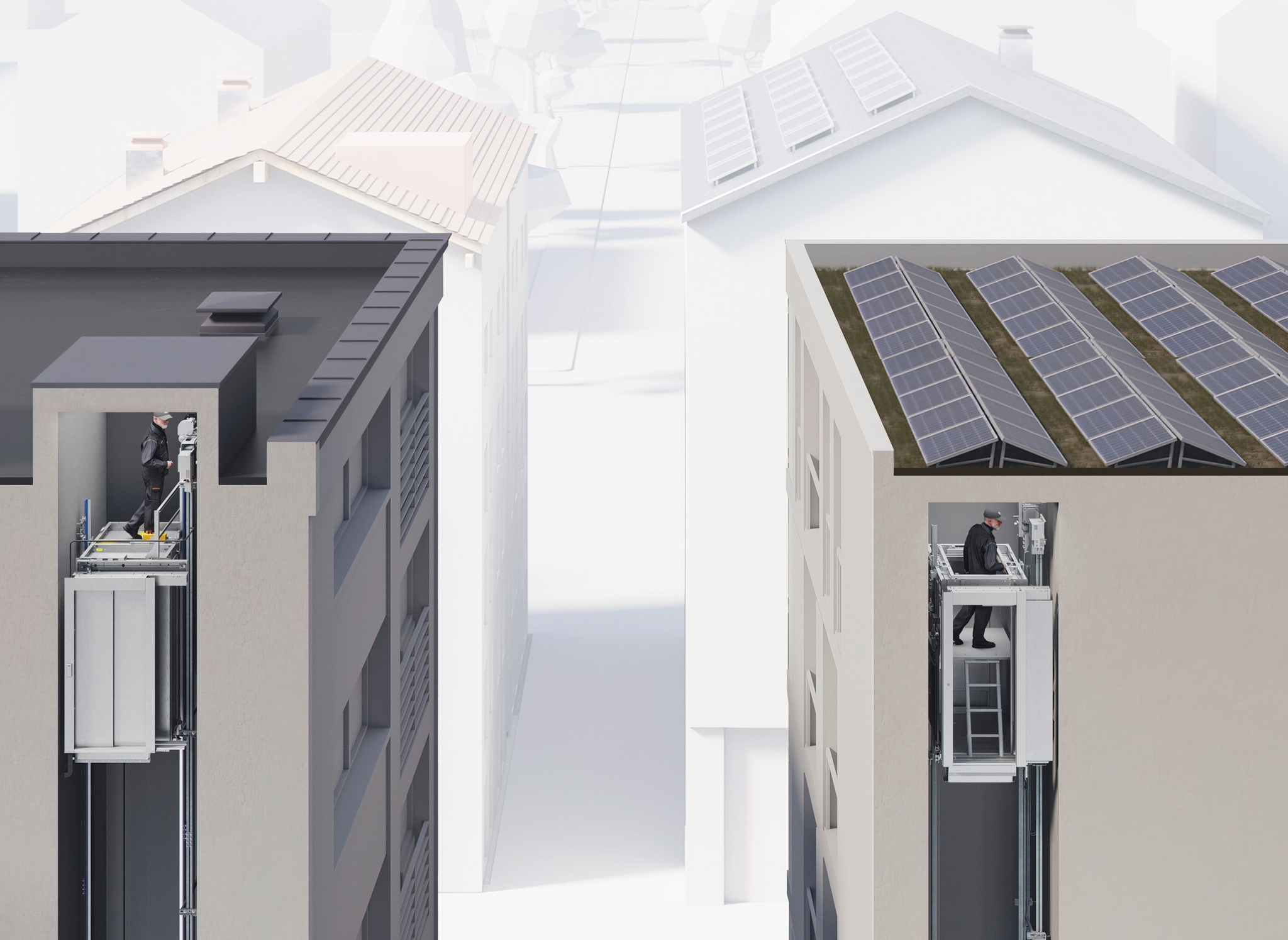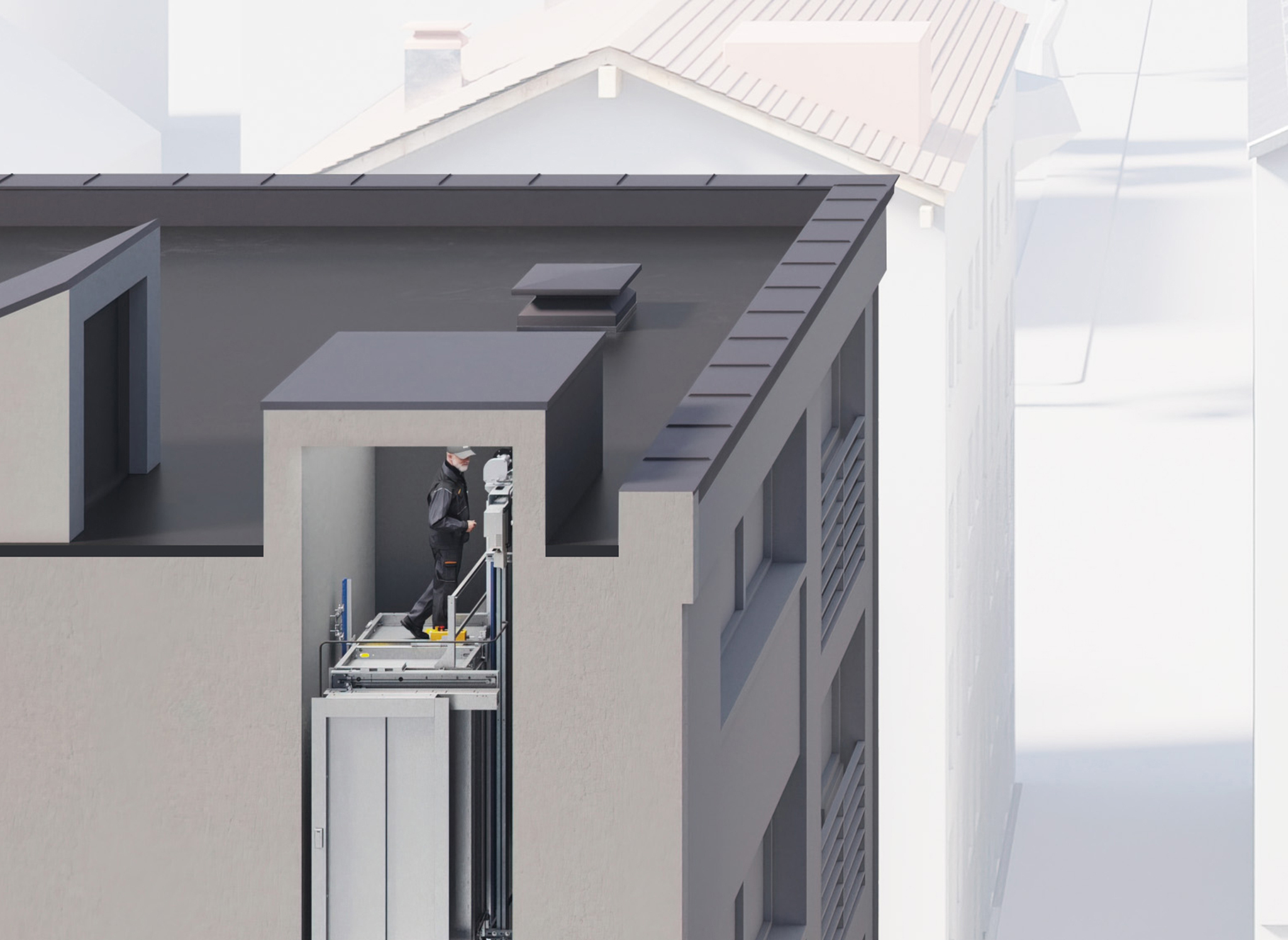When building in densely populated urban areas, every millimetre and every second counts. With the option of the extra-reduced shaft head and reduced shaft pit, EOX saves on vertical space and construction time. Shortening the shaft head to a room-height level means that architects and planners no longer have to design the top floor and roof around a higher elevator shaft, and contractors don’t get caught up with ceiling penetrations and superstructures.
EOX with extra-reduced shaft head and reduced pit

In this visualisation, the buildings on the left side of the street feature EOX elevators with a standard shaft head requiring roof superstructures. Buildings on the right feature EOX elevators with extra-reduced shaft head resulting in an obstacle-free roof for terraces, PV panels, etc.
Scan the QR code with your phone or visit brochure.tkelevator.com/en-TKE/eox
Explore all benefits of the extra-reduced shaft head
Click on the buttons to see the details.

Standard shaft head with roof superstructure
EOX with extra-reduced shaft head

Go back to overview
Maintenance: In a standard-height shaft head the lift technicians board the cabin roof to service the components located in the shaft head. With the help of an inspection remote control and at very slow speed they can move the cabin. Strict safety protocols incl. mandatory wearing of protective gear are applied.
Superstructures limit the use of a building’s roof. Photovoltaic systems have to be planned around it, public or private terraces are difficult to establish. All in all, there’s less space to use or rent with maximum profitability, and the building’s potential market appeal is not fully exploited.
Shaft head: Its purpose is to accommodate components located inside the elevator shaft, e.g. the drive. Besides, if the lift technician has to board the cabin roof to perform routine maintenance, a safety zone of at least 1 m is mandatory. For both reasons, a standard elevator shaft head is usually around 3400 mm. The height is measured from the finished floor level of the top landing.
On buildings with pitched roofs superstructures for the elevator have a sizeable impact on the building’s aesthetics and complicate the construction of the roof.
Construction: Because a standard shaft head usually exceeds the available room height, it literally has to “stick out” of the roof. The resulting superstructure adds complexity to the construction process – from the scheduling, to concrete casting, thermal insulation and waterproofing – and also increases the costs.

Go back to overview
For the regular maintenance of EOX elevators with an extra-reduced shaft head the lift technician does not need to board the cabin roof. Instead, all service tasks are carried out from within the cabin, thanks to a working platform that folds out from the special cabin ceiling. The mandatory safety zone for the technician to retreat in case of unintended car movement is now inside the cabin rather than on top of it, crucially reducing the required shaft head height.
The ceiling-high shaft head reduces construction complexity. Because there is no need for a superstructure on the roof, the final concrete slab can be poured in one go, saving costs and time. The lack of a larger ceiling penetration also improves roofing durability and reduces the risk of water leaks.
Buildings where a pitched roof design is desired or required by building regulations benefit on multiple fronts from EOX with an extra-reduced shaft head: Superstructures on the roof are avoided. Additional costs and construction time is saved. Roof space is freed up for photovoltaic or thermal solar systems. In case of a building refurbishment the extra-reduced shaft head makes EOX an ideal candidate for a retrofit installation, because it will literally fit right under the roof.
Thanks to the extra-reduced elevator shaft head ending with the final roof slab, the unobstructed roof surface can be used to the maximum for photovoltaic systems, HVAC units etc.
The extra-reduced shaft head eliminates architectural constraints in the building design, especially when it comes to devising floor plans and rooftop layouts. Whether it’s the creation of penthouse apartments, private or community terraces, maisonettes or rooftop gardens – there’s a certainty for architects, planners and constructors that the lift won’t get in the way of their creative ideas or execution plans.
For the extra-reduced shaft head option the elevator components located in the shaft head such as the lightweight EOX belt drive are installed in a special, very compact and low build-up layout, further reducing the required space in height.

Further information on the application of extra-reduced shaft head and reduced pit
The extra-reduced shaft head and reduced pit options are available exclusively for EOX elevators with max. 1 m/s. Reduced shaft pit is applicable to all cabin sizes, including flexible cabin sizes. Extra-reduced shaft head is applicable only to standard dimension cabins: 450 kg (1000×1250 and 1000×1300 mm), 630 kg (1100×1400 mm), 825 kg (1350×1400 mm) and 1000 kg (1100×2100 mm). Minimum achievable shaft head is dependent on the chosen rated load, cabin height, door height and door type as well as door model. For example, the lowest extra-reduced shaft head of 2500 mm is achieved at 630 kg with 2100 mm cabin height and a low-buildup door model of 2000 mm height. Combination of extra-reduced shaft head and reduced pit is possible, although restrictions may apply depending on the specific configuration of your EOX elevator. Your Authorized Distributor for TKE will gladly guide you through the planning process for your project.